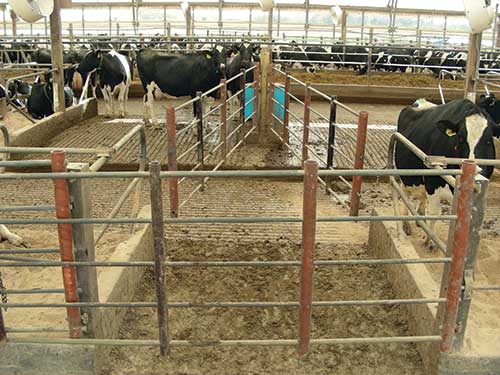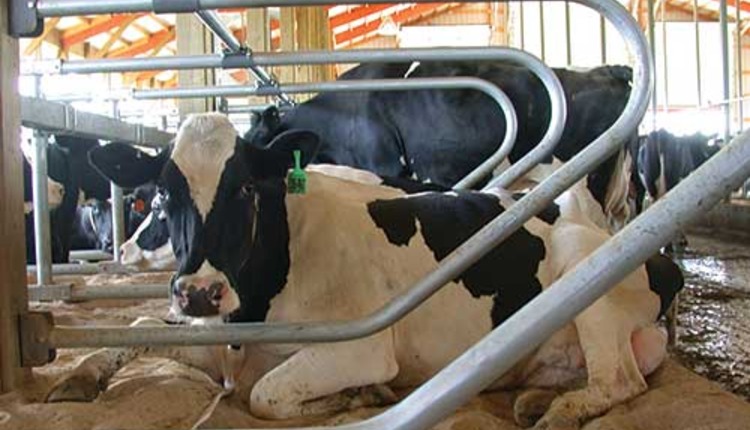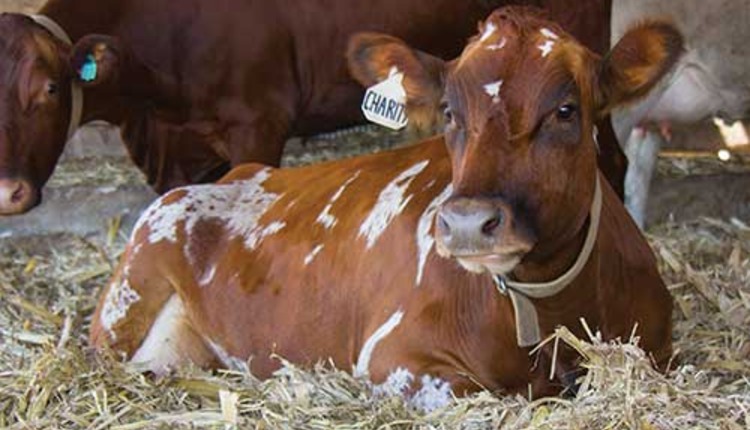The authors are with the School of Veterinary Medicine, University of Wisconsin-Madison.
There are four characteristics of excellent transition cow housing, as recommended by the Dairyland Initiative:
Go step by step
First, decide how cows will be managed at calving. Will the cow deliver her calf where she has been housed or be moved to a separate pen after the onset of labor when the calf's nose or feet are showing?
In addition to the physical space where the calf is delivered, two social issues come into play. First, it is important to avoid moving a cow into a new social group during the period three to seven days before calving. Second, a cow should not be left alone and isolated from her group for more than a few hours.
A "traditional" approach where cows are moved from a single dry period group to a group maternity bedded pack pen within a couple days of calving can be successful, provided the time in the group maternity pen is limited to two days or less. Excellent stockmanship skills to predict imminent calving are critical for success.
Because it is difficult to predict calving within a couple of days, other systems may be more feasible. Stable social groups of cows due to calve within a one-week period of time can be established at the time of drying off or as late as three weeks before the expected due date. Each group remains intact with no movement between groups.
If stable social groups are housed on bedded packs or in open lots, the cows can deliver the calf right in that space. Group bedded pack pens should provide a minimum of 100 square feet (9.3 square meters) of bedded area per cow, not including the feeding area. If the close-up cows are housed in freestalls, a round-the-clock workforce is required to identify cows that have begun labor and need to be moved to a calving pen.
Calving or maternity pens in general should be located close to the prefresh cows and away from heavy traffic areas. Individual calving pens should have a bedded area of at least 12 feet by 12 feet, with a headlock in one corner and a gate to facilitate single-handed capture. This area allows plenty of room for the herdsman to operate behind the cow and use a calving aid if needed.
Room to eat and rest
The next priority is to provide enough feedbunk and resting space. Usually sized to hold cows for three weeks, the prefresh pen is the only pen where the cow gets to decide when to leave. Because her departure is determined by calving date, this pen should have the capacity to accommodate a wide variation in throughput.
In postfresh pens, cows can be removed early if there is a surge in numbers. We are often asked what the optimal duration of stay is in this pen. The answer is highly variable, as some cows may be ready to handle a move to a larger group at Day 10, while other cows may need three or more weeks. Because a primary purpose of the postfresh pen is to make it easier to detect cows that need medical attention, we suggest a 21- to 30-day stay that will encompass the high-risk period for most fresh cow disease events.
The traditional approach to sizing transition cow pens is to calculate the average number of calvings per week and then multiply by the target number of weeks in the pen. By default, pens designed in this manner are overstocked half of the time with predictable deterioration of fresh cow health.
We recommend sizing prefresh and postfresh pens for 140 percent of the average number of calvings. The "excess" space and stalls are justifiable. Each stall or feeding space in the transition pen is a positive factor in the success of each fresh cow, and each stall helps to launch between 10 and 15 lactations per year. The benefits of each stall or space are multiplied 10 to 15 times and justify the recommendations to oversize.
Two-row freestall layouts with appropriate numbers of crossovers of an appropriate width will generally provide approximately 30 inches of feedbunk space per cow, provided that the pen is not overstocked relative to stalls. Fully stocked three-row pens can be an acceptable choice for far-off dry cows but will not provide sufficient bunk space for close-up cows.
Prefresh freestalls used in a "just-in-time" calving program should be designed so that workers can see the rear end of every lying cow without having to enter the pen and cause a disruption. This is achieved with a head-to-tail layout that allows the workers to see the tail end of all the cows from the feed alley. Alternatively, a drover's lane on the back side of the pen and a feed alley on the front will allow the appropriate views.
Barn design matters
Think next about alleys and stalls. Dimensions for alleys, crossovers and freestalls can be found on the Dairyland Initiative website at http://thedairylandinitiative.vetmed.wisc.edu. In transition cow pens, more frequent crossovers every 12 to 15 stall widths (about 60 feet) are recommended to improve feeding space.
Facilitate cow movement with a drover's alley at least 8 feet wide along the outside wall. Exits to the lane are through access ports in the outside row of stalls, usually shared by two pens. A gate is opened to close off the cross alley, and the cow is brought into the triangle (see photo below).

Properly designed gates make the handling of transition cows an easier and less stressful process.
Prefresh freestalls, in particular, need to accommodate the ample size of pregnant cows and allow for some clumsiness in their rising and lying motions. For mature Holstein cows, freestalls of 52 inches or greater width and 10 feet in length are recommended. Compromises may be made for mixed-age groups where prefresh cows are penned with smaller prefresh heifers.
Bedding choice is an important decision as well, as fresh cow performance is improved by the provision of a soft resting surface throughout the transition period. Parturition is a difficult process at the best of times, but it is even more challenging for lame cows on a firm surface. Surfaces such as sand, compost, deep straw and similar materials provide substantial advantages for fresh cow health over firmer surfaces such as rubber-crumb mattresses or packed earth and concrete.
The final step in planning any dairy facility is to ask if the design makes economic sense. We will examine this question in the next article.
Click here to return to the Animal Care E-Sources
1406_401
There are four characteristics of excellent transition cow housing, as recommended by the Dairyland Initiative:
- 30 inches of bunk space per cow from 21 days before to 21 days after calving
- A soft bed - sand-bedded freestalls or a clean, dry bedded pack
- Sufficient resting space in a well-designed stall or bedded pack
- Social stability during the last seven days before calving
Go step by step
First, decide how cows will be managed at calving. Will the cow deliver her calf where she has been housed or be moved to a separate pen after the onset of labor when the calf's nose or feet are showing?
In addition to the physical space where the calf is delivered, two social issues come into play. First, it is important to avoid moving a cow into a new social group during the period three to seven days before calving. Second, a cow should not be left alone and isolated from her group for more than a few hours.
A "traditional" approach where cows are moved from a single dry period group to a group maternity bedded pack pen within a couple days of calving can be successful, provided the time in the group maternity pen is limited to two days or less. Excellent stockmanship skills to predict imminent calving are critical for success.
Because it is difficult to predict calving within a couple of days, other systems may be more feasible. Stable social groups of cows due to calve within a one-week period of time can be established at the time of drying off or as late as three weeks before the expected due date. Each group remains intact with no movement between groups.
If stable social groups are housed on bedded packs or in open lots, the cows can deliver the calf right in that space. Group bedded pack pens should provide a minimum of 100 square feet (9.3 square meters) of bedded area per cow, not including the feeding area. If the close-up cows are housed in freestalls, a round-the-clock workforce is required to identify cows that have begun labor and need to be moved to a calving pen.
Calving or maternity pens in general should be located close to the prefresh cows and away from heavy traffic areas. Individual calving pens should have a bedded area of at least 12 feet by 12 feet, with a headlock in one corner and a gate to facilitate single-handed capture. This area allows plenty of room for the herdsman to operate behind the cow and use a calving aid if needed.
Room to eat and rest
The next priority is to provide enough feedbunk and resting space. Usually sized to hold cows for three weeks, the prefresh pen is the only pen where the cow gets to decide when to leave. Because her departure is determined by calving date, this pen should have the capacity to accommodate a wide variation in throughput.
In postfresh pens, cows can be removed early if there is a surge in numbers. We are often asked what the optimal duration of stay is in this pen. The answer is highly variable, as some cows may be ready to handle a move to a larger group at Day 10, while other cows may need three or more weeks. Because a primary purpose of the postfresh pen is to make it easier to detect cows that need medical attention, we suggest a 21- to 30-day stay that will encompass the high-risk period for most fresh cow disease events.
The traditional approach to sizing transition cow pens is to calculate the average number of calvings per week and then multiply by the target number of weeks in the pen. By default, pens designed in this manner are overstocked half of the time with predictable deterioration of fresh cow health.
We recommend sizing prefresh and postfresh pens for 140 percent of the average number of calvings. The "excess" space and stalls are justifiable. Each stall or feeding space in the transition pen is a positive factor in the success of each fresh cow, and each stall helps to launch between 10 and 15 lactations per year. The benefits of each stall or space are multiplied 10 to 15 times and justify the recommendations to oversize.
Two-row freestall layouts with appropriate numbers of crossovers of an appropriate width will generally provide approximately 30 inches of feedbunk space per cow, provided that the pen is not overstocked relative to stalls. Fully stocked three-row pens can be an acceptable choice for far-off dry cows but will not provide sufficient bunk space for close-up cows.
Prefresh freestalls used in a "just-in-time" calving program should be designed so that workers can see the rear end of every lying cow without having to enter the pen and cause a disruption. This is achieved with a head-to-tail layout that allows the workers to see the tail end of all the cows from the feed alley. Alternatively, a drover's lane on the back side of the pen and a feed alley on the front will allow the appropriate views.
Barn design matters
Think next about alleys and stalls. Dimensions for alleys, crossovers and freestalls can be found on the Dairyland Initiative website at http://thedairylandinitiative.vetmed.wisc.edu. In transition cow pens, more frequent crossovers every 12 to 15 stall widths (about 60 feet) are recommended to improve feeding space.
Facilitate cow movement with a drover's alley at least 8 feet wide along the outside wall. Exits to the lane are through access ports in the outside row of stalls, usually shared by two pens. A gate is opened to close off the cross alley, and the cow is brought into the triangle (see photo below).

Prefresh freestalls, in particular, need to accommodate the ample size of pregnant cows and allow for some clumsiness in their rising and lying motions. For mature Holstein cows, freestalls of 52 inches or greater width and 10 feet in length are recommended. Compromises may be made for mixed-age groups where prefresh cows are penned with smaller prefresh heifers.
Bedding choice is an important decision as well, as fresh cow performance is improved by the provision of a soft resting surface throughout the transition period. Parturition is a difficult process at the best of times, but it is even more challenging for lame cows on a firm surface. Surfaces such as sand, compost, deep straw and similar materials provide substantial advantages for fresh cow health over firmer surfaces such as rubber-crumb mattresses or packed earth and concrete.
The final step in planning any dairy facility is to ask if the design makes economic sense. We will examine this question in the next article.
1406_401











